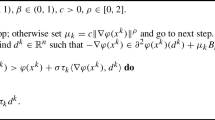Abstract
We consider an inverse quadratic programming (QP) problem in which the parameters in both the objective function and the constraint set of a given QP problem need to be adjusted as little as possible so that a known feasible solution becomes the optimal one. We formulate this problem as a linear complementarity constrained minimization problem with a positive semidefinite cone constraint. With the help of duality theory, we reformulate this problem as a linear complementarity constrained semismoothly differentiable (SC1) optimization problem with fewer variables than the original one. We propose a perturbation approach to solve the reformulated problem and demonstrate its global convergence. An inexact Newton method is constructed to solve the perturbed problem and its global convergence and local quadratic convergence rate are shown. As the objective function of the problem is a SC1 function involving the projection operator onto the cone of positively semi-definite symmetric matrices, the analysis requires an implicit function theorem for semismooth functions as well as properties of the projection operator in the symmetric-matrix space. Since an approximate proximal point is required in the inexact Newton method, we also give a Newton method to obtain it. Finally we report our numerical results showing that the proposed approach is quite effective.
Similar content being viewed by others
References
Ahuja RK, Orlin JB (2001) Inverse optimization. Oper Res 49: 771–783
Ahuja RK, Orlin JB (2002) Combinatorial algorithms for inverse network flow problems. Networks 40: 181–187
Bonnans JF, Shapiro A (2000) Perturbation analysis of optimization problems. Springer, New York
Burton WR, Toint PhL (1992) On an instance of the inverse shortest paths problem. Math Prog 53: 45–61
Cai MC, Yang XG, Zhang J (1999) The complexity analysis of the inverse center location problem. J Global Optim 15: 213–218
Clarke FH (1983) Optimization and nonsmooth analysis. Wiley, New York
Facchinei F (1995) Minimization of SC1 functions and the Maratos effect. Oper Res Lett 17: 131–137
Facchinei F, Fischer A, Kanzow C (1996) Inexact Newton methods for semismooth equations with applications to variational inequality problems. In: Di Pillo G, Giannessi F (eds) Nonlinear optimization and applications. Plenum Press, New York, pp 125–139
Facchinei F, Jiang H, Qi L (1999) A smoothing method for mathematical programs with equilibrium constraints. Math Prog 85: 107–134
Facchinei F, Pang JS (2003) Finite-dimensional variational inequalities and complementarity problems, vol I, II. Sringer, New York
Fukushima M, Pang JS (1999) Convergence of a smoothing continuation method for mathematical problems with complementarity constraints, Ill-posed Variational Problems and Regularization Techniques. In: Théra M, Tichatschke R(eds) Lecture Notes in Economics and Mathematical Systems, vol 477. Springer, Berlin, pp 105–116
Heuberger C (2004) Inverse combinatorial optimization: a survey on problems, methods and results. J Comb Optim 8: 329–361
Higham NJ (1988) Computing a nearest symmetric positive semidefinite matrix. Linear Algebra Appl 103: 103–118
Hiriart-Urruty JB, Lemaréchal C (1993) Convex analysis and minimization algorithms. Springer, Berlin
Hiriart-Urruty JB, Strodiot JJ, Nguyen VH (1984) Generalized Hessian matrix and second-order optimality conditions for problems with C 1,1 data. Appl Math Optim 11: 43–56
Iyengar G, Kang W (2005) Inverse conic programming with applications. Oper Res Lett 33: 319–330
Kummer B (1991) Lipschitzian inverse functions, directional derivatives, and applications in C 1,1-optimization. J Optim Theory Appl 70: 561–582
Lin GH, Fukushima M (2005) A modified relaxation scheme for mathematical programs with complementarity constraints. Ann Oper Res 133: 63–84
Luo ZQ, Pang JS, Ralph D (1996) Mathematical programs with equilibrium constraints. Cambridge University Press, Cambridge
Meng F, Sun D, Zhao G (2005) Semismoothness of solutions to generalized equations and the Moreau-Yosida regularization. Math Prog 104: 561–581
Mifflin R (1977) Semismooth and semiconvex functions in constrained optimization. SIAM J Control Optim 15: 959–972
Pang JS, Sun D, Sun J (2003) Semismooth homeomorphisms and strong stability of semidefinite and Lorentz complementarity problems. Math Oper Res 28: 39–63
Qi L, Sun J (1993) A nonsmooth version of Newton’s method. Math Prog 58: 353–367
Rockafellar RT (1974) Conjugate duality and optimization. SIAM, Philadelphia
Rockafellar RT, Wets RJB (1998) Variational analysis. Springer, New York
Scholtes S (2001) Convergence properties of a regularization scheme for mathematical programs with complementarity constraints. SIAM J Optim 11: 918–936
Sun D (2001) A further result on an implicit function theorem for locally Lipschitz functions. Oper Res Lett 28: 193–198
Sun D (2006) The strong second order sufficient condition and constraint nondegeneracy in nonlinear semidefinite programming and their implications. Math Oper Res 31: 761–776
Sun D, Sun J (2002) Semismooth matrix valued functions. Math Oper Res 27: 150–169
Sun D, Sun J, Zhang L (2008) The rate of convergence of the augmented Lagrangian method for nonlinear semidefinite programming. Math Prog 114: 349–391
Tseng P (1998) Merit functions for semi-definite complementarity problems. Math Prog 83: 159–185
Zarantonello EH (1971) Projections on convex sets in Hilbert space and spectral theory I and II. In: Zarantonello EH (eds) Contributions to nonlinear functional analysis. Academic Press, London, pp 237–424
Zhang J, Liu Z (1996) Calculating some inverse linear programming problems. J Comput Appl Math 72: 261–273
Zhang J, Liu Z (1999) A further study on inverse linear programming problems. J Comput Appl Math 106: 345–359
Zhang J, Liu Z, Ma Z (2000) Some reverse location problems. Eur J Oper Res 124: 77–88
Zhang J, Ma Z (1999) Solution structure of some inverse combinatorial optimization problems. J Comb Optim 3: 127–139
Zhang J, Zhang L (2010) An augmented Lagrangian method for a class of inverse quadratic programming problems. Appl Math Optim 21: 57–83
Author information
Authors and Affiliations
Corresponding author
Rights and permissions
About this article
Cite this article
Zhang, J., Zhang, L. & Xiao, X. A Perturbation approach for an inverse quadratic programming problem. Math Meth Oper Res 72, 379–404 (2010). https://doi.org/10.1007/s00186-010-0323-4
Received:
Accepted:
Published:
Issue Date:
DOI: https://doi.org/10.1007/s00186-010-0323-4




